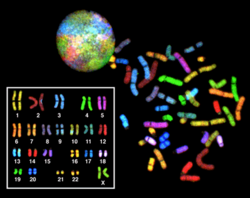Spectral Karyotyping
Spectral karyotyping (SKY) is a molecular cytogenetic method that marks all pairs of human chromosomes in one hybridization.
Marking methodology[edit | edit source]
The Spectral Karyotyping (SKY) method is similar to M-FISH method. The SKY method uses a mixture of differently labeled dye probes to label chromosomes. Each probe hybridizes with a different chromosome according to its complementarity. Based on this, we can distinguish all 24 human chromosomes. Different probes are distinguished by the use of different fluorochromes and their combinations. For example, the probe on the 1st chromosome is labeled with fluorochrome A, the probe on the 2nd chromosome is labeled with fluorochrome B, the probe on the 3rd chromosome is labeled with a combination of fluorochromes A+B.
- the total number of combinations k is given by the formula: k = 2n-1 where n is the number of dyes used.
If we substitute n = 5, we find that using 5 fluorochromes we get enough combinations to label all 24 human chromosomes.
Signal evaluation[edit | edit source]
A fluorescence microscope equipped with a Sagnac interferometer is used to detect individual signals . The image created by the interferometer is then captured by a camera, transferred to a computer, and special software then distinguishes all the color shades of the chromosomes.
Links[edit | edit source]
Related articles[edit | edit source]
External links[edit | edit source]
References[edit | edit source]
- KOČÁREK, Eduard – PÁNEK, Martin – NOVOTNÁ, Drahuše. Klinická cytogenetika 1. 2., upravené vydání edition. Praha : Karolinum, 2010. 134 pp. ISBN 978-80-246-1880-7.



